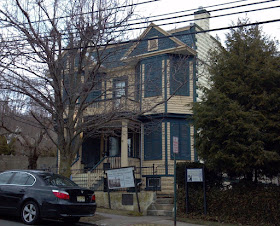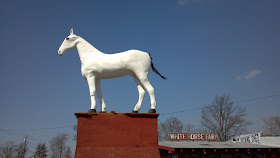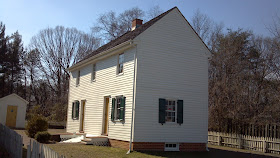I've talked
before about the surprising amount of life it's possible to find in the depths of winter, even as it seems the weather will never get warm again. Walking around with open eyes and ears can clue you in to the ways nature is preparing to renew itself as the days get longer. Check out your own neighborhood, and you'll see that in some ways, spring is already here.
And as I discovered last weekend, there's a lot going on in other places, too. With sunset approaching last Saturday evening, Ivan and I met up with about a dozen folks from the
Fyke Nature Association to watch for woodcocks at Great Swamp National Wildlife Refuge. These long-billed shorebirds prefer damp grassy marshland, and one spot at the refuge is well-known as a mating season hotspot.
What makes the American woodcock so fascinating that a bunch of people will stand around in a swamp at dusk waiting for it? Well, it's always interesting to witness courtship behavior, but the woodcock's routine is pretty distinct for birds that nest in New Jersey. If you were to relate it to that of young humans, we were about to see the avian version of a nightclub in a college town: pick-up lines and a bit of dancing, with the males hoping to impress the ladies. The dance, in particular, is an improvement over what most other local birds tend to do: stand around and sing their version of "hey baby, hey baby, hey baby."
The male woodcock announces the start of the ritual with a short, adenoidal buzzing noise that is usually described with the mneumonic "peent" (or, for others, electronic flatulence). If you didn't know better, you might confuse it for an odd out-of-season cricket, or maybe a frog of some sort. He will continue "peent"ing from his well-obscured spot on the ground until he takes flight. Rising 40 feet up in the air, he performs an aerial display of dips and climbs, his wings whistling all the while. For a sampling of these sounds, check out Cornell University's
All About Birds page on the woodcock.
 |
| The woodcock: big eyes, long bill, short legs. |
We waited patiently for twilight to settle, noticing that early-season moths were beginning to come out for the evening. In the waning moments of light, we started to hear the buzzing calls in a brushy area. One brave individual started a series of calls, a little erratically spaced. He was totally obscured on the ground among the taller grasses and shrubbiness, so it would be harder to see as he rose in flight. With so many eyes on the lookout, chances were that at least some of us would get a glimpse. Soon a few other individuals started making noise from other areas, giving our guy a little competition.
Patience is your friend when birding, and waiting for woodcock is a prime example. You can't hurry them up, and when they do rise, you're sometimes following the sound overhead more than a visible body. After a bit of peenting, our guy ascended and flew around like a stunt pilot on adrenaline, his wings twittering the path of his speedy and looped flight. He dropped back to the ground as quickly as he'd risen, and there was silence for a few moments until we heard....
"Peent."
"Well, I guess that didn't work," someone said, and we all laughed. All that work and the woodcock had come up short in the new girlfriend category. Time to start from scratch again.
Our first woodcock flight seen, more sounds began to emerge. You expect a lot of nature noises on a warm summer night, but early March has its songs in the swamp, too. Now that I wasn't so focused on hearing every peent, my ears opened to the rushing sounds of ducks (and geese) flying to their nighttime settling places. Ivan even spied the sound of what might have been a bullfrog croaking in a pond several yards away.
Peenting became more frequent and from other quarters, and we were startled when two separate woodcocks flew past us, just a few feet overhead. With their large, dark eyes, it was surely easier for them to see us in the darkness than the other way around. Things were livening up, for sure!
Then we had an even bigger surprise visitor -- two, actually. The larger bird coming toward us had a much deeper wingstroke and more substantial body, flying purposefully past us toward a wooded area, its partner not far behind. Heard calling earlier by a few in our group, the great horned owls were out for the night, no doubt looking for a meal. Seeing them was a nice little bonus, unexpected but not out of place.
Birding at dusk has its limitations, of course: you can only watch so long before natural light is extinguished, and artificial light won't help your cause. Nature had been good to us that evening, and the only thing left to do was find our way to our cars without incident.
 Such is the case with Seabrook, deep in Cumberland County. Despite the countless hours I've spent banging around back roads and farmland, I'd never found a single sign of its fascinating history. In fact, without knowledge that the community is part of the larger Upper Deerfield Township, it's hard to find Seabrook at all. I knew that somewhere in that flat expanse had been a unique place that had made agricultural history and achieved a level of cultural diversity few rural communities could boast.
Such is the case with Seabrook, deep in Cumberland County. Despite the countless hours I've spent banging around back roads and farmland, I'd never found a single sign of its fascinating history. In fact, without knowledge that the community is part of the larger Upper Deerfield Township, it's hard to find Seabrook at all. I knew that somewhere in that flat expanse had been a unique place that had made agricultural history and achieved a level of cultural diversity few rural communities could boast.














